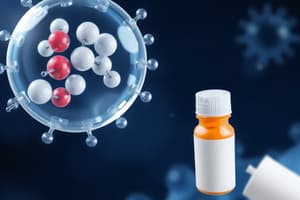Podcast
Questions and Answers
During which period did what we recognize as 'science' begin to take shape?
During which period did what we recognize as 'science' begin to take shape?
- Eighteenth Century
- Seventeenth Century
- Nineteenth Century
- Early Middle Ages – 1200s CE (correct)
Which philosophical approach emphasizes acquiring knowledge through reason rather than received ideas?
Which philosophical approach emphasizes acquiring knowledge through reason rather than received ideas?
- Rationalism (correct)
- Empiricism
- Inductivism
- Positivism
What significant shift occurred in Western medicine due to new scientific approaches?
What significant shift occurred in Western medicine due to new scientific approaches?
- End of humoral theory (correct)
- Introduction of surgical methods
- Reevaluation of herbal remedies
- Emphasis on religious healing practices
Which of the following concepts relates to developing laws from observable phenomena?
Which of the following concepts relates to developing laws from observable phenomena?
What impact did scientific methods have on the practice of medicine in the nineteenth century?
What impact did scientific methods have on the practice of medicine in the nineteenth century?
What is the primary role of drug-metabolizing enzymes (DMEs) in the body?
What is the primary role of drug-metabolizing enzymes (DMEs) in the body?
During metabolism, how does the structure of a drug typically change?
During metabolism, how does the structure of a drug typically change?
Which of the following best describes a pro-drug?
Which of the following best describes a pro-drug?
What is a common consequence of drug metabolism?
What is a common consequence of drug metabolism?
Which of the following statements about metabolites is true?
Which of the following statements about metabolites is true?
What distinguishes fortified wine from regular wine?
What distinguishes fortified wine from regular wine?
What is a significant characteristic of ethanol's pharmacokinetics?
What is a significant characteristic of ethanol's pharmacokinetics?
Which of the following is NOT a source for whiskey?
Which of the following is NOT a source for whiskey?
How does food intake affect alcohol absorption?
How does food intake affect alcohol absorption?
Which combination of ingredients best describes port?
Which combination of ingredients best describes port?
What does pharmacodynamics refer to?
What does pharmacodynamics refer to?
What does the term 'ADME' stand for in pharmacology?
What does the term 'ADME' stand for in pharmacology?
What does 'F(oral)' represent in the context of drug absorption?
What does 'F(oral)' represent in the context of drug absorption?
A drug with a molecular weight greater than 600 g/mol is likely to have which of the following issues?
A drug with a molecular weight greater than 600 g/mol is likely to have which of the following issues?
What is the primary reason for drugs having a therapeutic window?
What is the primary reason for drugs having a therapeutic window?
Why might drug bioavailability be less than 100%?
Why might drug bioavailability be less than 100%?
What does the term 'plasma concentration-time profile' help define?
What does the term 'plasma concentration-time profile' help define?
Which type of administration is generally considered most convenient for taking medicines?
Which type of administration is generally considered most convenient for taking medicines?
What is a key factor that affects a drug's ability to cross lipid-rich cell membranes?
What is a key factor that affects a drug's ability to cross lipid-rich cell membranes?
What is the main goal of pharmaceutical innovation regarding drug safety?
What is the main goal of pharmaceutical innovation regarding drug safety?
What primarily influences the peak BAC (Cmax) after alcohol ingestion?
What primarily influences the peak BAC (Cmax) after alcohol ingestion?
Which factor contributes to females experiencing a higher peak BAC compared to males?
Which factor contributes to females experiencing a higher peak BAC compared to males?
What is the primary enzyme responsible for alcohol metabolism in the liver?
What is the primary enzyme responsible for alcohol metabolism in the liver?
What is the typical metabolic rate of alcohol in a 70 kg human?
What is the typical metabolic rate of alcohol in a 70 kg human?
Which of the following describes the role of NAD in alcohol metabolism?
Which of the following describes the role of NAD in alcohol metabolism?
What is a potential consequence of a polymorphism in the ALDH2*2 gene?
What is a potential consequence of a polymorphism in the ALDH2*2 gene?
Which route is responsible for the excretion of a small quantity of alcohol?
Which route is responsible for the excretion of a small quantity of alcohol?
What percentage of alcohol is typically exhaled directly in breath?
What percentage of alcohol is typically exhaled directly in breath?
Flashcards are hidden until you start studying
Study Notes
Scientific Medicine & Humoral Theory
- Scientific thought, as we know it today, truly flourished around the 1200s CE, with the 18th century marking a significant rise in scientific approaches across various fields.
- Scientific methods were applied to medicine, particularly in the 19th century, leading to a shift from the traditional humoral theory of disease.
- Humoral theory's limitations became evident as it lacked measurable evidence.
- New scientific approaches focused on identifying measurable causes of diseases, their patterns, durations, and responses to specific treatments, making medicine more effective and less risky.
Pharmacokinetics: How the Body Processes Drugs
- Pharmacology involves studying how drugs interact with the body.
- Pharmacokinetics (PK) focuses on the movement of drugs within the body, including absorption, distribution, metabolism, and excretion (ADME).
- Pharmacodynamics (PD) focuses on how the drug affects the body.
- A drug's specific properties determine its PK and PD profiles.
- Understanding drug concentrations in blood over time (plasma concentration-time profile) is crucial for determining the "therapeutic window," the range where the drug effectively treats the condition without causing harm.
Absorption: How Drugs Enter the Body
- The oral route is the most common method of drug administration.
- Drug absorption involves the movement of ingested drug molecules from the gastrointestinal (GI) tract into the portal blood.
- The oral bioavailability (F) refers to the fraction of the ingested dose that reaches the systemic circulation.
- Factors like the drug's size, lipophilicity (greasiness), and charge can impact its bioavailability.
- Larger molecules, hydrophilic drugs, and ionized drugs tend to have poor bioavailability due to their difficulty crossing lipid-rich cell membranes in the gut wall .
Metabolism: How the Body Modifies Drugs
- The body uses drug-metabolizing enzymes (DMEs) to convert drugs into water-soluble metabolites for easier excretion.
- DMEs are found in various tissues, including the gut wall, liver, kidney, and other tissues.
- Metabolism often reduces a drug's activity by altering its structure, but some metabolites retain pharmacological activity.
- Some drugs are inactive until metabolized (pro-drugs) whereas some drug metabolites can be toxic.
Alcohol: Pharmacokinetic Considerations
- Ethanol, the alcohol in alcoholic beverages, exhibits amphipathic properties, meaning it has both water-loving (hydrophilic) and fat-loving (lipophilic) characteristics.
- These properties contribute to its rapid absorption and wide tissue penetration.
- Alcohol is absorbed primarily from the upper intestine and stomach.
- Food can delay gastric emptying and alcohol absorption.
- The peak blood alcohol concentration (BAC) depends on the type of beverage and the amount consumed.
- Alcohol is distributed throughout the body via the bloodstream with a greater presence in the total body water (TBW) due to its high water solubility.
- Women tend to have higher peak BACs than men due to their smaller body size, lower proportion of TBW, and potentially lower levels of EtOH metabolizing enzymes.
Alcohol: Metabolism & Elimination
- Alcohol metabolism primarily occurs in the liver via enzymes like alcohol dehydrogenase (ADH) and aldehyde dehydrogenase (ALDH).
- This metabolism requires the cofactor NAD (nicotinamide adenine dinucleotide).
- Under normal conditions, alcohol metabolism is saturated due to limited liver NAD capacity, resulting in a fixed rate of alcohol metabolism, approximately 8g/hr in a 70kg person.
- Genetic variations in ADH and ALDH genes, like the ALDH2*2 polymorphism in East Asians, can influence alcohol metabolism and acetaldehyde levels.
- Small amounts of alcohol are excreted directly in the urine and breath.
Studying That Suits You
Use AI to generate personalized quizzes and flashcards to suit your learning preferences.




